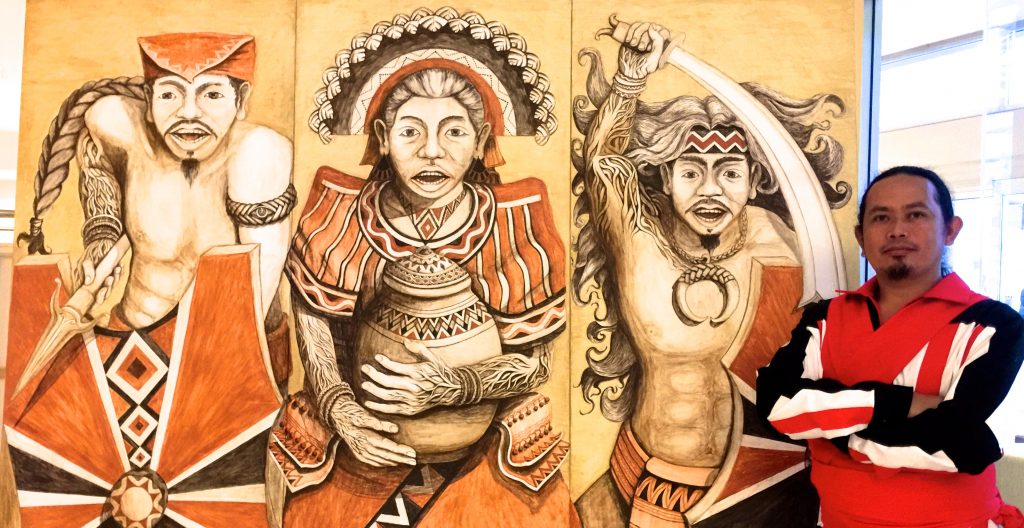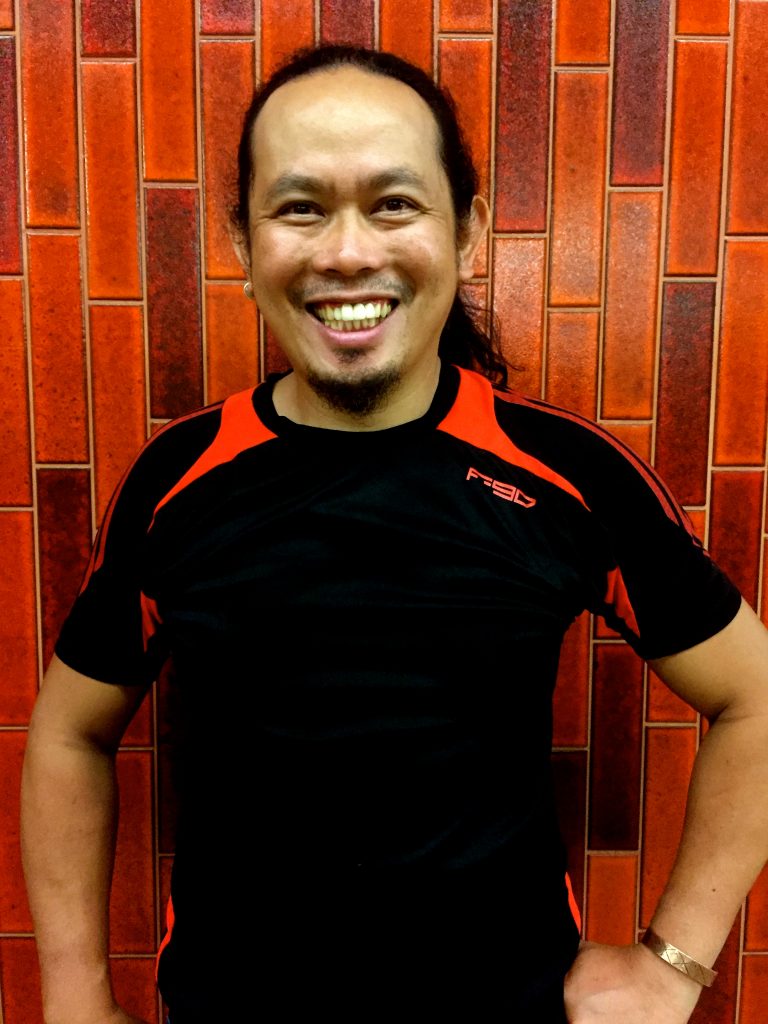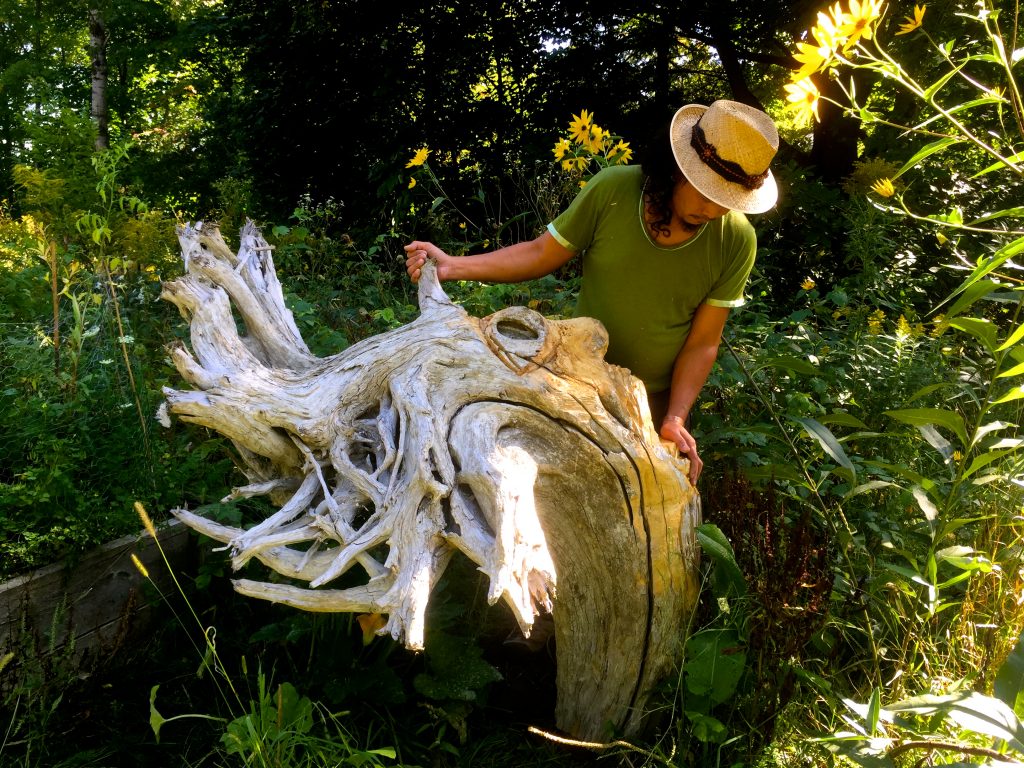Filipino-Canadian In Focus
Soil Painting: Soliman Poonon’s artworks made out of nature

We see nature often gracing artworks, but for a Talaandig visual artist from the Philippines, nature is not just his theme — it is what his pieces are made out of.
Through soil layered on his canvas, Soliman Poonon’s narratives are built.
One with nature
Before nature played a key role in his pieces, it has always been a big part of his life and of his tribe: the Talaandig.
Composed of hunters, farmers, warriors and artisans, the Talaandig tribe is one of the seven indigenous groups in the province of Bukidnon in Mindanao. Soliman grew up close to nature, being born on Kamambungan mountain in 1984 to a family of 13.
For the young Soliman, nature was his playground. One of his memorable moments there was shouting “Aeroplano, sakay ko!” whenever he saw an airplane flying overhead.
Kamambungan mountain was a lively place even though it was a few kilometers away from neighbouring houses and cities where they get essential goods like rice, sugar, salt, matches, rope, and clothes. But as time went by, the once full of life mountain slowly became overgrown and barely populated.
People living there began moving to towns and cities; even his family transferred to a village at its foothills when he was eight years old. Although most of them have permanent houses in other places, they still go to Kamambungan mountain to tend their farms.
Living in the same village the Poonon family moved into is his uncle Rodelio “Waway” Saway; the bridge that linked him to the art of soil painting.
Stories in soil, told through soil
Most of Soliman’s memories had nature as his witness, and as many people know, stories can be learned through a witness.
Yet, at the same time, nature can be used to visualize narratives from one’s mind — that was what he saw from his Uncle Waway.
“It was here that I saw my uncle painting with soil outside his house. Captivated by the art, I would stand and watch for hours.”
His connection to soil painting became deeper as he grew older. From only observing, he moved up into becoming his Uncle Waway’s apprentice, whose task was to put the finishing touches on the paintings.
“The first time I was handed a paintbrush and asked to help out with details in a painting, I became enamoured with the work.”
With this, there were two types of tools he usually used each day. He would start his mornings picking up farming tools to help his father out on the farm, and then change it to art tools in the afternoons to help his uncle with the paintings.
Soliman wanted to take a step further in this field, but acquiring art supplies was not an easy task.
At that time, Soliman had no idea where to get it nor a budget to buy it, however, he was determined to have his own gear. He worked on the farm to earn enough funds for his art tools, which he successfully gathered after two years.
Collecting and processing his medium, he said, also needs “more of a personal effort.”
Unlike other art media which colours come in one package or can be bought in one store, Soliman has to go through the foothills of Mount Kitanglad to collect different colours of soil. In Bukidnon, there are 14 colours identified.
After collecting his medium, Soliman would sift it, ground it, and store it. The soil would be subsequently mixed with water and glue, and it is only then that he can paint it on a canvas in layers.
“These layers draw out immense detail and brilliant colours. For example, one painting may require at least five layers which means the same image is painted over that many times to achieve the vividness of detail and colour.”
Soil as his medium is more natural and accessible for Soliman, but the main reason why he chose to employ it in his art is that it keeps him “connected to where I am when painting and to the living stories in the soil.”
Stories and culture of the Talaandig people are his driving force in making masterpieces.
The Talaandig tribe, despite colonization and modernization, continues to practice its indigenous customs and beliefs. As a visual artist, it is Soliman’s goal to preserve it for the future generation.
“I am inspired to paint our elders and old-time ways of living… the handcrafts and hard labours of their daily lives and the myths and epics that guided them.”
“I especially want to provide coming generations evidence of their ancestry so that they have images that they can refer to when practicing living traditions.”
His years of experience as an apprentice strengthened him to stand on his own feet.
“I chose to devote myself wholly to art and gave myself the challenge of creating five new, original works. When my uncle saw these paintings, he invited me to participate in a group exhibit that would take place at the Xavier University art museum in Cagayan de Oro City; that’s about four hours away from where I live.”
This opened the door of opportunity, leading him to join in other competitions, shows, and group exhibits as a member of the Talaandig Soil Painters group.
He bagged the title of being the regional winner of the prestigious Philippine Art Award in his second attempt at the biennial national art competition; the prize money he received from it was used to purchase materials for a house he started constructing for himself.
Building his own house has been Soliman’s dream since he was 15 years old. His inspiration for this was his grandfather, Pablito Poonon, who managed to establish a well-built traditional home on his own.
Like how he was inspired by his grandfather, Soliman also wanted to motivate his younger brothers to make their own houses and help them set those up. Soliman was 22 years old when he started working on his own house.
While participating in local exhibitions, Soliman also did farming and carpentering.
He has had to take other jobs to continue his art and take care of his basic needs like food and electricity. Should there be extra funds, he would allocate it for the art supplies and promotional materials. There were times that he depended on the aid of donors as, he said, there were no sufficient funds from the government to support the livelihood of the artists.
Booking exhibitions in his hometown was also difficult because there were not many galleries or art-friendly venues in their village.
“Art collectors live far away and it can be challenging to maintain ongoing communication with them. Weather changes, power outages, and little extra money make it difficult to continue payments for the phone and internet.”
“When patrons come to call, I need to be ready to open my home and show my work. You never know when a spontaneous visit can lead to an art sale. Those rare chances to make or continue good relations with patrons are precious and any in-person exchange is highly valuable.”
Although faced with challenges, the amount of blessings showered to him outweighed it.
Numerous donations, both cash and tools, poured in for the Talaanding Soil Painters, which came from various organizations and individuals who wanted to support their art.
They established their own name while showcasing their craft to people who are visiting the Talaandig ancestral territory, as well as to the exhibitions that they went to. Media coverage featuring their soil paintings also helped them to gain more exposure in other parts of the world.
“My uncle was driven to get us known. He used many of his contacts to gain us invitations.”
The group, however, eventually dissolved, but Soliman continued his career as a visual artist.
In November 2018, he conducted his first solo exhibit where, this time, all the works there were done in ink on paper. It was a small, local show he titled, “Alima,” which means “the act of care in life and relationship.”
It was in that same year when Soliman was granted a visitor visa to see his wife, Andrea Vargas, and their son in Canada. This trip was initially meant for him to reunite with his family… until it had another purpose.
Employing Canadian soil
Although born and raised in Canada, Andrea is a Filipino by blood; her family was originally from the Bicol Region in the Philippines.
Andrea and Soliman’s relationship started when Andrea flew to the Philippines in 2014 to visit the Talaandig community as part of her ancestral pilgrimage to deepen her understanding and connection to her pre-colonial Philippine culture. Upon meeting Andrea at that time, Soliman immediately started courting her. They dated, and after several trips to the Philippines, they took their relationship to the next level as they tied the knot in 2016 and welcomed their firstborn in 2017.
The new parents, however, were faced with a difficult situation after their son’s birth.
“Andrea had a traumatic response to the events. Becoming a mother for the first time and being so far from where she grew up, still learning the local language and customs and being very underslept from tending to a newborn, she developed extreme postpartum.”
For her to rest and recuperate, Andrea’s parents decided to take her and their grandchild to Canada, but as much as Soliman wanted to go too, he did not have the documents yet needed to enter the country.
Soliman was separated from his wife and son for nearly a year. Fortunately, he was granted a visitor’s visa to go to Canada, finally seeing them in December 2018 in Surrey, British Columbia.
“Initially, it was exciting to be in a new country. It was my first time to travel so far from everything familiar to me. I was very glad to be reunited with my wife and son.”
His first days in Canada went by with him adjusting to its timezone and environment, learning his way around their house, and catching up with his family.

But as days flew by, Soliman began longing for his hometown and feeling unwell.
“My life in the Philippines is a physically active one and it was odd to not have a lot to do, to not know where to go, to not be able to work and have no art projects.”
“I was bored. As a visitor, I was not allowed to work. I [got] sick a lot [during] the first few months while adjusting to a different climate. I started to wonder about deep things like the purpose of my life. I hit a wall, feeling stuck.”
Meeting with other Filipinos in the country and hearing their stories was what got him out of this phase. This was where the trip turned into having another purpose: bringing soil painting he learned from the Talaandig community to a foreign country.
Andrea introduced Soliman to her Filipino-Canadian friends and it was through her that he met visual artist Bert Monterona, whom he told about his soil painting.
“We immediately hit it off after discovering that he is Talaandig via his lola (grandmother). He was so excited about my use of soil and shared every possible exhibit opportunity with me.”
Bert’s encouragement and help were some of the reasons that pushed Soliman to get back to art and showcase soil painting in Canada.
Since his visit to the country was primarily to be with his family, his art materials were not with him. Looking for those was not a problem as he is always surrounded by nature; getting the tools is.
In Bukidnon, Soliman can go to a lot of places to collect everything he needs for his artwork. It can be in the mountain, forest, or nearby pathways, and for his other gear, he can just get it in art or hardware stores in nearby cities.
It was different in B.C. Nature there offers a lot of raw materials but it cannot be easily accessed, unlike the ones he finds in Bukidnon. He was told not to touch the raw materials and he found that the tools being sold in Canadian stores were too expensive.
There might be certain places where the materials are off-limits but nature is everywhere.
One day while Soliman was walking in the woods, he found and collected several colours of the earth. For his other tools, it was provided to him by Bert.
A place where he can create his art also didn’t become a problem for Soliman since Bert lent him a space in his art studio. Apart from that, Bert also helped him gain exposure in Canada by giving his name to organizers looking for artists to put in the spotlight.
“I owe him a lot of gratitude for his relentless encouragement and immense generosity. It is thanks to him that I was blessed to show my work in five exhibits in less than one year.”

Among the exhibits he took part in while in Canada was the How Green Is Your Muse (HGIYM) exhibit at the Surrey Art Gallery in 2019, along with other Filipino-Canadian visual artists to celebrate nature. Soliman was invited by the Filipino Music and Art Foundation, nominated by fellow artist Esmie Gayo McLaren.
Nature, besides taking a vital role in his life and being his medium in telling stories, has also been inspiring him to paint.
For the HGIYM exhibit, he used Canadian soil to create six paintings that he submitted for review and among those, two artworks were chosen to be featured.
“I am satisfied with these pieces. I believe both their themes are strong and that they provide a diverse example of the different ways I paint.”
Aside from joining exhibitions, Soliman — along with Andrea, Bert, Mylene Maranoc, Jr Guerrero, and Chris Nazaire — formed a group called the League of United Minds for Arts and Development (LUMAD). Their mission is to support the rights of Lumads, which means indigenous, and share their stories, traditions, and culture.
Soliman only stayed in Canada for a few months but his visit there was filled with loads of good memories. Nearly one year later, Soliman, along with his wife and son, returned to the Philippines in November 2019.
Back to PH
Now back in his homeland, Soliman and his family are living in the house that he built himself with the help of their relatives and neighbors.
He had prior plans, including continuing his art practice and renovating their home but with the COVID-19 pandemic, these were all hampered.
Since their return, Soliman has been focusing on farming and on his family, especially now that they grew bigger with the addition of their newborn in November 2021. If the repair works in their house continue, Soliman will build his own art studio and gallery that will serve as his working space and shelter for his art pieces.
Once that happens, booking an art show in their area will be one less problem with the construction of his art gallery.
“From here, I will conduct workshops, host showings, and sell crafts.”
While some paintings will be put on sale, his other works, especially the ones about the stories and culture of the Talaandig tribe, will be planted in their ancestral territory as an important reminder of their roots.
“Our chiefs (Datu/Bae) and elders (pasagi) have worked to continue practicing indigenous customs so that age-old information is not easily forgotten and so that younger generations may know what cultural traditions the Talaandig people have.”
“So much learning and lifestyle has become modern. Perhaps with these paintings, young people will better remember what preceded them and from whence they come.”
Soliman has probably more stories about the Talaandig tribe and nature that he has yet to narrate in his soil paintings, which will be seen not only by his countrymen but also by those abroad. If given the opportunity again, Soliman will travel the rest of the world, taking with him these living stories that are told through soil.






















Jam Allysa Montajes
March 14, 2022 at 11:52 AM
Wow! This is a pure talent that needed more recognition
Ariel
March 15, 2022 at 11:10 PM
What an indeed talent, this proves that we filipinos are really talented in different aspects,before, it is not new to us that nature is really a common subject in most art works but who would have thought that aside from being a subject of artwoks it could actually be a meduim of artworks as well.this shows how sharp and innovative filipino minds could be. This articles not only amused me but also taught me some lessons, such as “learnig is a process, and it really takes time” like how soliman started his artworks from obserbing his uncle and eventually doing it on his own.soliman didn’t only show his great talent but also show his roots and thier culture, thier tribe “talaandig” must be so proud of him. Soliman taught me that if we able to be on top someday we should never forget where we came from.